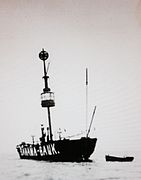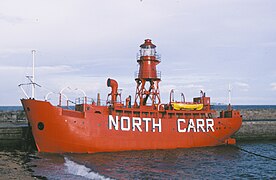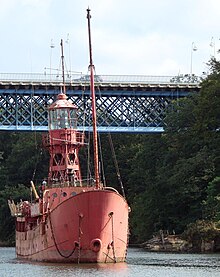Lightvessel stations of Great Britain

The history of the many lightvessel stations of Great Britain goes back over 250 years to the placement of the world’s first lightship at the Nore in the early 18th century.
A lightvessel station is a named position at which a lightvessel was placed, rather than a particular ship; individual vessels were often transferred between different stations during their existence. Stations themselves were occasionally changed, especially during wartime, when lights were only displayed in response to specific shipping needs.
History[edit]
The world’s first lightvessel was the result of a business partnership between Robert Hamblin, a former barber and ship manager from King’s Lynn, and David Avery, an investor.[1] In 1730 the pair secured a government licence to moor a ship, with a prominent light affixed to it, to serve as a navigation aid at the Nore in the Thames mouth. Hamblin and Avery intended to profit from the vessel by collecting a fee from passing merchant vessels. The licence was opposed by Trinity House, which considered that it possessed a monopoly on construction and maintenance of navigation aids in British waters. After extensive legal dispute the licence was revoked in 1732 and Trinity House assumed direct responsibility for the proposed lightship; Hamblin and Avery were granted nominal lease revenues in exchange.[2] The Nore lightship commenced operations in 1734.[3]
A second lightvessel was placed at the Dudgeon station, off the Norfolk coast, in 1736, with others following at Owers Bank (1788) and the Goodwin Sands (1793).[3] While the Admiralty opposed the 1802 Sunk lightvessel, claiming it would aid enemy ships, it soon afterwards placed three vessels of its own to protect the fleet during the Napoleonic Wars; they were taken over by Trinity House a few years later.[4] Many others were commissioned during the nineteenth century, especially off England’s east coast and the approaches to the Thames, where there were many treacherous shoals.

Following their acquisition of the Admiralty ships, all English and Welsh lightvessels were maintained by Trinity House, with the exception of the four vessels in the approaches to the River Mersey, which were maintained by the Mersey Docks and Harbour Board until 1973, and those in the Humber Estuary, which were the responsibility of the Humber Conservancy Board.
Communications and safety[edit]
Communication with lightvessels proved to be a major problem for Trinity House; lightvessel crews were well-placed to observe ships in distress, but could not always alert lifeboats on shore. After a series of shipwrecks, an experiment was conducted whereby a nine-mile undersea cable was run from the Sunk lightvessel in the Thames Estuary to the post office at Walton-on-the-Naze. This was intended to commence in 1884, but was plagued by delays;[5] the trial was unsuccessful as the cable repeatedly broke.
As a result of a motion brought forward by Sir Edward Birkbeck, a Royal Commission was established to look at the issue of ‘electrical communication’ and gave its first Report in 1892;[6][7] the East Goodwin lightvessel was used during one of Guglielmo Marconi’s early experiments in radio transmission in 1896.[8] The world’s first radio distress signal was transmitted by the East Goodwin lightvessel’s radio operator on 17 March 1899, after the merchant vessel Elbe ran aground on the Goodwins, while on 30 April that year, the East Goodwin vessel transmitted a distress signal on its own behalf, when the SS R. F. Matthews rammed it in a dense fog. Safety was further improved by the development of more powerful lamps and through the replacement by foghorns of the gongs previously used as fog signals.
Crew[edit]
Until the second half of the 20th century, all Trinity House vessels were permanently manned. An 1861 article in the Cornhill Magazine described lightshipmen as being paid 55 shillings a month (in addition to drawing 1 shilling and sixpence a week “in lieu of 3 gallons of small-beer”): the vessels were supplied, and the crews relieved, once a month. It was also noted that “a general tone of decent, orderly and superior conduct” was observed, that the men were “very respectable […] swearing and profane language are […] prohibited” and that every man was supplied with a Bible as well as “a library of varied and entertaining literature”.[9]
By the start of the 20th century, Trinity House lightvessels had a crew of 11, of whom seven (a master and six ratings) would be on active duty at any one time. It was an extremely demanding and dangerous profession, and it would take 15 to 20 years of service to be promoted to master.[10]
Replacement[edit]
The majority of British lightvessels were decommissioned during the 1970s – 1980s and replaced with light floats or LANBY buoys, which were vastly cheaper to maintain: in 1974 at the time of Trinity House’s original development project, lightship annual running costs at £30,000 were ten times those of the LANBY.[11]
The remaining UK lightvessels have now been converted to unmanned operation and most now use solar power.[citation needed]
Vessels[edit]
Unlike lightships in the United States and other parts of the world, Trinity House lightvessels were usually unpowered and needed to be towed to or from their position. In order to act as effective daymarks they were painted red, with the station name in large white letters on the side of the hull, and a system of balls and cones at the masthead for identification. The first revolving light was fitted to the Swin Middle lightvessel in 1837: others used occulting or flashing lights. White lights were preferred for visibility though red and very occasionally green (as with the Mouse lightvessel) were also used.[12]
It is likely that photographs on various websites showing named lightvessels, may appear to be structurally different to comparable records on other web pages due to the fact that the particular vessel might have been withdrawn from a station after photographing and being towed away for drydocking, overhaul and possible direction to a new station and therefore a different lightvessel would have been substituted at the named station on withdrawal of the previous lightvessel. This has been most evident on those vessels that have been withdrawn and shipped to another port at home or abroad to become a floating museum, floating restaurant, ‘clubhouse’, etc. Scarweather LV and Helwick LV have for instance changed their rôle in their lifetime and their appearance on various records varies considerably.
England[edit]
Active stations[edit]
The following are active stations at which Trinity House still maintains unmanned lightships, which also act as weather stations.
Former stations[edit]
-
South Goodwin on station in 2006
-

Lightvessel on Crosby station during WW2
Scotland, Isle of Man[edit]
Lightvessels in Scotland and the Isle of Man were maintained by the Northern Lighthouse Board, with the exception of those maintained by the Clyde Lighthouse Trust and by the Dundee Port Trustees. Of the NLB vessels, only the North Carr was crewed.
-

The Bahama Bank Lightship, date unknown
-

North Carr lightship in 1988


Former Welsh lightships were maintained by Trinity House. Remaining substitute navigational aids still are.
See also[edit]
References[edit]
- ^ Naish, J. M. Seamarks: Their History and Development, Stanford Maritime, 1985, ISBN 978-0-540-07309-2, p. 107
- ^ The Nautical Magazine and Naval Chronicle for 1865. Cambridge University Press. 2013. p. 624. ISBN 9781108054911.
- ^ a b Marcus, G.J. (1975). Heart of Oak: A Survey of British Sea Power in the Georgian Era. Oxford University Press. pp. 53–54. ISBN 0192158120.
- ^ a b Renton (2001) Lost Sounds: the story of coast fog signals, Dundurn, p.148
- ^ BOARD OF TRADE — TELEGRAPHIC COMMUNICATION WITH LIGHT VESSELS, Hansard 16-05-1884
- ^ COAST COMMUNICATIONS, Hansard 26-04-1892
- ^ COMMUNICATION WITH LIGHTHOUSES, Hansard 21-03-1893
- ^ Baker, W. J. (1998). History of the Marconi Company. Routledge. pp. 39–40. ISBN 978-0-415-14624-1.
- ^ Light-Vessels, The Cornhill Magazine, III (1861), 39.
- ^ Trinity House, portcities.org, accessed 02-09-08
- ^ Rowlands, D. “Points of Reference”, Design 310 (1974)
- ^ Miltoun, F. (ed) Ships and Shipping, Moring Ltd, 1903, Ch. 11
- ^ https://www.marinetraffic.com/en/ais/details/ships/shipid:849825/mmsi:992351033/imo:0/vessel:FOXTROT_3_LV
- ^ https://www.ibiblio.org/lighthouse/lightships.htm
- ^ a b c d NGA List of Lights, Radio Aids and Fog Signals, National Geospatial-Intelligence Agency, Wikidata Q13872896
- ^ https://www.trinityhouse.co.uk/lighthouses-and-lightvessels/east-goodwin-lightvessel
- ^ https://www.trinityhouse.co.uk/lighthouses-and-lightvessels/greenwich-lightvessel
- ^ https://web.archive.org/web/20150924012054/http://www.feuerschiffseite.de/SCHIFFE/ENGLAND/lv05/lv5gb.htm
- ^ Reeds PBO Small Craft Almanac 2014. ISBN 978-1-4081-9330-3. OL 32692860M. Wikidata Q25198336.
- ^ https://www.trinityhouse.co.uk/lighthouses-and-lightvessels/sevenstones-lightvessel
- ^ https://www.marinetraffic.com/en/ais/details/ships/shipid:849819/mmsi:992351027/imo:0/vessel:SUNK_INNER
- ^ MarineTraffic, Wikidata Q18518862
- ^ https://www.trinityhouse.co.uk/notice-to-mariners/13-15-bar-lighted-buoy-and-float
- ^ https://confidentials.com/liverpool/birth-of-a-new-planet
- ^ https://www.nationalhistoricships.org.uk/register/1572/light-vessel-23-mersey-bar
- ^ “Nautical Notices”, Nautical Magazine, v. XLVII (New Series), No XI (Nov 1878), 1031
- ^ a b “Notice to Mariners”, Board of Trade Journal, v7 (1889), 617-618
- ^ a b The Gull’, lightvessel 38, Thurrock Council, accessed 02-12-21
- ^ https://www.thurrock.gov.uk/history-on-river-thames/gull-lightvessel-38
- ^ http://museumcollections.hullcc.gov.uk/collections/storydetail.php?irn=7&master=10
- ^ https://www.nationalhistoricships.org.uk/register/144/light-vessel-78-calshotspit
- ^ a b https://www.nationalhistoricships.org.uk/register/131/light-vessel-16-inner-dowsing
- ^ a b c https://web.archive.org/web/20160327090123/http://broadcasting-fleet.com/kingdavid2.htm
- ^ https://www.nationalhistoricships.org.uk/register/645/light-vessel-88
- ^ a b https://www.ibiblio.org/lighthouse/engse.htm
- ^ Trinity House, portcities.org
- ^ https://www.trinitybuoywharf.com/architecture/lightship-lv95
- ^ a b https://www.nationalhistoricships.org.uk/register/2872/light-vessel-93
- ^ http://www.tynebuiltships.co.uk/O-Ships/outerdowsing1925.html
- ^ Naish, J. (1985) Seamarks: their history and development, Stanford, p.108
- ^ David MacDonald (Director); Alberto Cavalcanti (Producer) (1940). Men of the Lightship (Film (35mm, 24 mins, black & white)). GPO Film Unit.
- ^ a b c d e f Radio Navigational Aids, Naval Oceanographic Office, 1973, Wikidata Q7280925
- ^ US Navy Hydrographic Office (1919) Index to Notices to Mariners, 1-52, p.177
- ^ Carter, G (1974) The Battle of Britain: the Home Front, Mason & Lipscomb, pp.190-1
- ^ https://www.wrecksite.eu/wreck.aspx?73273
- ^ Defense Mapping Agency (1977), Notices to Mariners, p.5
- ^ a b https://friendsoflv50.org.uk/history/
- ^ “Girdler Lightship loss”.
- ^ Stevenson (2013) The World’s Lighthouses: From Ancient Times to 1820, Courier, p.124
- ^ https://www.lightphotos.net/photos/displayimage.php?pos=-1844
- ^ https://www.liverpoolmuseums.org.uk/artifact/photograph-of-haisbro-lightship-68-0
- ^ https://www.nationalhistoricships.org.uk/register/137/light-vessel-91-humber
- ^ a b http://offshoreradiomuseum.co.uk/page832.html
- ^ The London Gazette 25290 (PDF), The London Gazette, Wikidata Q109152990
- ^ Imray and Kettle (1917) Pilot’s Guide for the River Thames: The South-east Coast of England, and the Strait of Dover, Imray, Laurie, Norie & Wilson, p.24
- ^ https://www.nationalhistoricships.org.uk/register/646/light-vessel-94-morecambe-bay
- ^ https://www.google.co.uk/books/edition/Light_in_the_Darkness/ShmtCwAAQBAJ
- ^ https://lv21.co.uk/history-of-lv21/crew-stories/
- ^ https://www.liverpoolmuseums.org.uk/artifact/photograph-of-newarp-lightship-83
- ^ https://www.nationalhistoricships.org.uk/register/488/light-vessel-86-nore
- ^ https://www.hslc.org.uk/wp-content/uploads/2017/06/97-9-Woods.pdf
- ^ https://friendsoflv50.org.uk/john-conway-master-of-outer-gabbard-light-vessel-lv50-1911/
- ^ Admiralty, Notices to Mariners 348, 1919
- ^ https://www.eastbourneherald.co.uk/news/traffic-and-travel/nostalgia-royal-sovereign-lightship-eastbourne-coast-957200
- ^ The London Gazette 25254 (PDF), The London Gazette, Wikidata Q109152953
- ^ https://lighthouseaccommodation.co.uk/directory/lv72-juno-lightvessel/
- ^ http://www.gosportheritage.co.uk/wordpress/wp-content/uploads/2018/02/lightship-brochure-1-Read-Only.pdf
- ^ The Disappearing Lightship, Goodwin Sands Conservation Trust, accessed 20-12-21
- ^ South Goodwin Light Vessel, portcities.org
- ^ “South Goodwin Lightvessel Trinity House History”. trinityhousehistory.wordpress.com. Retrieved 27 July 2017.
- ^ Historic England. “ST MARGARET’S OLD LIGHTHOUSE, St. Margaret’s At Cliffe (1070066)”. National Heritage List for England. Retrieved 27 July 2017.
- ^ https://goodwinsands.org.uk/the-disappearing-lightship/
- ^ https://www.nationalhistoricships.org.uk/register/671/light-vessel-12-spurn
- ^ https://www.nationalhistoricships.org.uk/register/2447/light-vessel-14-sula
- ^ https://www.marinetraffic.com/en/ais/details/ships/shipid:849826/mmsi:992351034/imo:0/vessel:SUNK_CENTR
- ^ The Nautical Magazine, v88 (1912), 360
- ^ https://www.nationalhistoricships.org.uk/register/139/light-vessel-38-gull
- ^ https://www.nationalhistoricships.org.uk/register/647/light-vessel-89-wash
- ^ Abertay Lightship, Dundee Maritime, accessed 22-12-21
- ^ http://www.lightkeepersjourney.com/bahama.html
- ^ US Navy Hydrographic Office, (1906) Notices to Mariners, nos 1-52, p.355
- ^ US Navy Hydrographic Office (1944), Supplement to British Islands Pilot: the western coast of Scotland from Mull of Galloway to Rudh’ Re and off-lying islands, Volume 4, p.2
- ^ Riddell, J.F.(1979) Clyde Navigation: A History of the Development and Deepening of the Clyde, John Donald, p.98
- ^ “Launches – Scotch”. The Marine Engineer, Feb 1, 1882, 254
- ^ Map of Skeirinoe lightvessel (via National Library of Scotland maps API (Map) (Popular Edition (Scotland) ed.). 1:253 440. Ordnance Survey. 1920–1930. Retrieved 13 August 2011.
- ^ https://lighthouseaccommodation.co.uk/directory/lv15-trinity-lightvessel/
External links[edit]
![]() Media related to Lightships of the United Kingdom at Wikimedia Commons
Media related to Lightships of the United Kingdom at Wikimedia Commons

Recent Comments